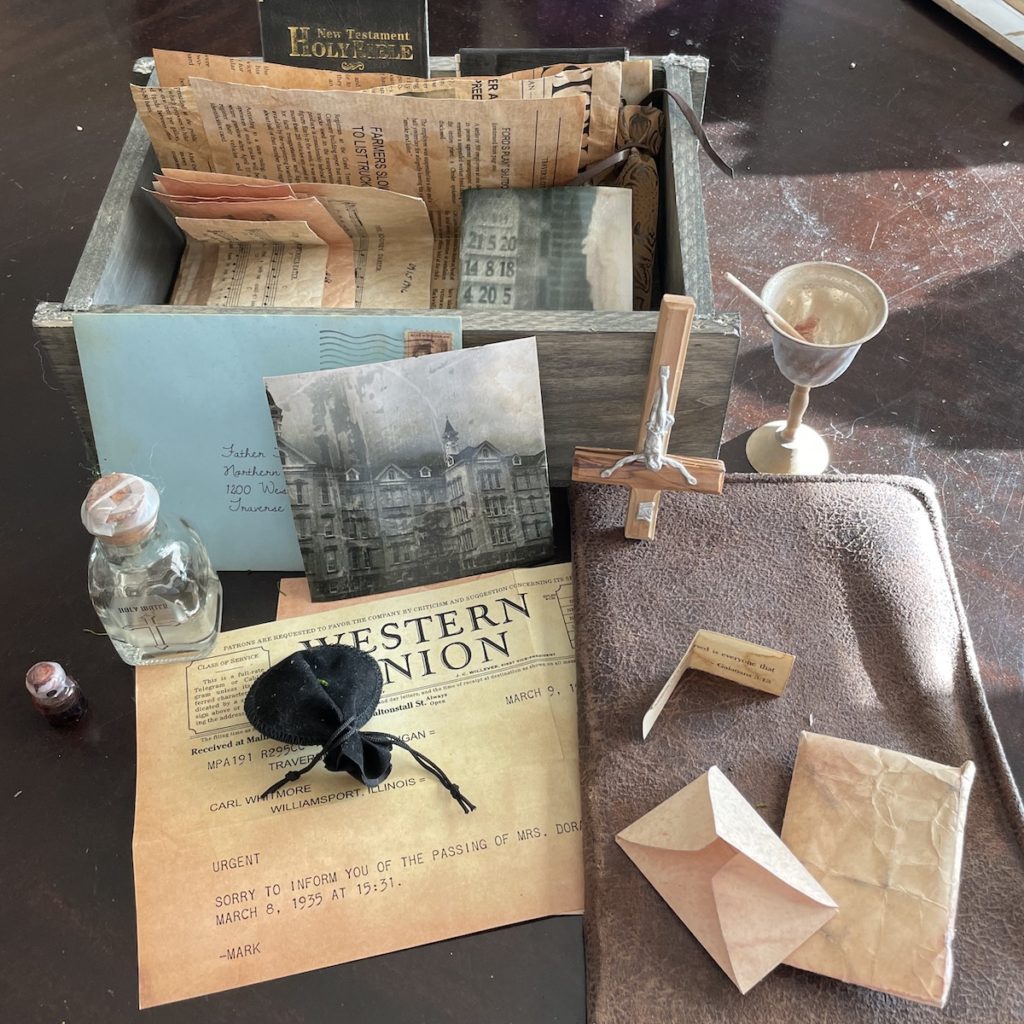
Root of All Evil
Review
Game Description
“A mysterious crate arrives on your doorstep packed with aged ephemera and artifacts. You are a character in this interactive-literature told through an old journal, newspaper clippings and other peculiar objects. Follow a newly ordained priest as he battles his demons – both real and imagined. Decode puzzles and solve the mystery surrounding an eerie tree on the grounds of the Northern Michigan Asylum. Can you locate the ritual and save the soul of the damned without sacrificing yourself in the process?”
Personal Experience
Crack-a-Nut Mysteries made the excellent S.O.U.P. and—given how excellent that game was to play through—I knew that I would be making my way through the rest of the Crack-a-Nut catalog before too long. So, when I ordered Root of All Evil, I suspected it would be good—what I didn’t expect was that it would be a heckin’ narrative masterpiece.
From the moment I opened the cardboard shipping box, I knew the game was something special: inside the shipping container was a wooden box accented with sprigs of moss on top of it and completely nailed shut. I had to grab a hammer to pull the nails out of the box, noticing an ominous looking latin phrase burned into the lid when I did so. Despite the latin warning, I forged ahead and pulled the—convincingly old—nails out of the box and opened the lid, only to discover that, much like Pandora, I had made a grave mistake. A nearly-poetic missive glued to the inside of the lid informed me of newly-acquired damnation. I would need to act quick, not to save myself, but to save those close to me.
Inside the box were a number of items that looked convincingly antique and worn; the centerpiece of which was a tattered journal. The journal provided the meat of the story and was surprisingly long and in-depth, taking me the better of an hour to read through. I was a bit worried initially when I saw the length of the journal, however I found it to be very well-written, compellingly dropping me directly into the mind of the box’s previous victim, a despicable priest who had his own encounter with the box.
One thing I really loved about the game is that the puzzles were almost all entirely optional, enhancing the story but not necessarily being required to complete the game. It was a long game too, requiring several sessions in order to finish it all. I left it out on my table between sessions and would often pause as I walked by and thumb through the journal, looking for clues, or pick up an item and try to suss out its purpose. At the end of the game, a series of nested envelopes was provided to offer up a few hints before ultimately ending with an answer sheet, that walks through all of the game’s puzzles and their solutions. After reading through, I was pleased to see that I had managed to find and solve all of them. Overall this experience was amazing and I enjoyed it so much, that I’ve already ordered Double Major.
Narrative
This is truly a narrative experience and is the best story I’ve seen in an at-home game so far. As mentioned, the journal is key to this, immersing you in the story and giving context to everything inside the box. The game also has one of the best endings I’ve ever seen in an at-home game, blending theater and magic in a way that made for a truly unforgettable experience.
The whole presentation, from the nailed-shut box (with its old square nails), to the antique-feeling components, and even to the smell of the items in the box, all felt like they could have come from the 1930s. The only thing in the entire kit that looked modern was a postcard that gave a bit of backstory on the (real!) setting and spelled out the game’s objective (the finding of which was apparently an issue for some of the early adopters of the game).
In a touch of veritas, many of the items in the box are included only because the narrative leaves you expecting them to be there, not because they’re used for a particular puzzle or another. It felt truly decadent in a sea of games that are only able to contain an optimized amount of paper components. (Not that there’s anything wrong with those games!)
There’s much more I’d like to say about the story and the compelling themes it offers, but I don’t want to spoil the experience for anyone else. All I’ll say is that at the core of the game is a complex, despicable character, and the game uses that friction to create and explore some very complicated themes.
Puzzle Play
As I mentioned, the puzzles in this game are not the core focus of the game, and many were optional, adding to the story instead of unlocking further puzzles. I really liked their narrative focus, they all felt mimetic to the experience, and were well-integrated into the story, enhancing immersion. Their challenge level will definitely depend on your experience level with ciphering, as the toughest ones were cipher-related, but they were all pretty well-written and fair.
Recommendation
This game is a dark and brooding experience filled with religious themes and a main character that expresses some abhorrent viewpoints. I’d put it about on-par with The Exorcist. It’s also not a very puzzle-heavy game. So if either of those give you pause, this may not be the experience for you.
Otherwise, if neither of those are an issue for you, I strongly recommend this game to anyone who is looking for a fantastic narrative and a presentation that is second to none.

Details
Type of Game: At Home Puzzle Game
Date Played: 2021-04-08
Price: $135
Company: Crack-a-Nut Mysteries
Website: https://crackanutmysteries.com/
Team Size: 1
Colorblind-friendly: Yes
Outcome: Win



